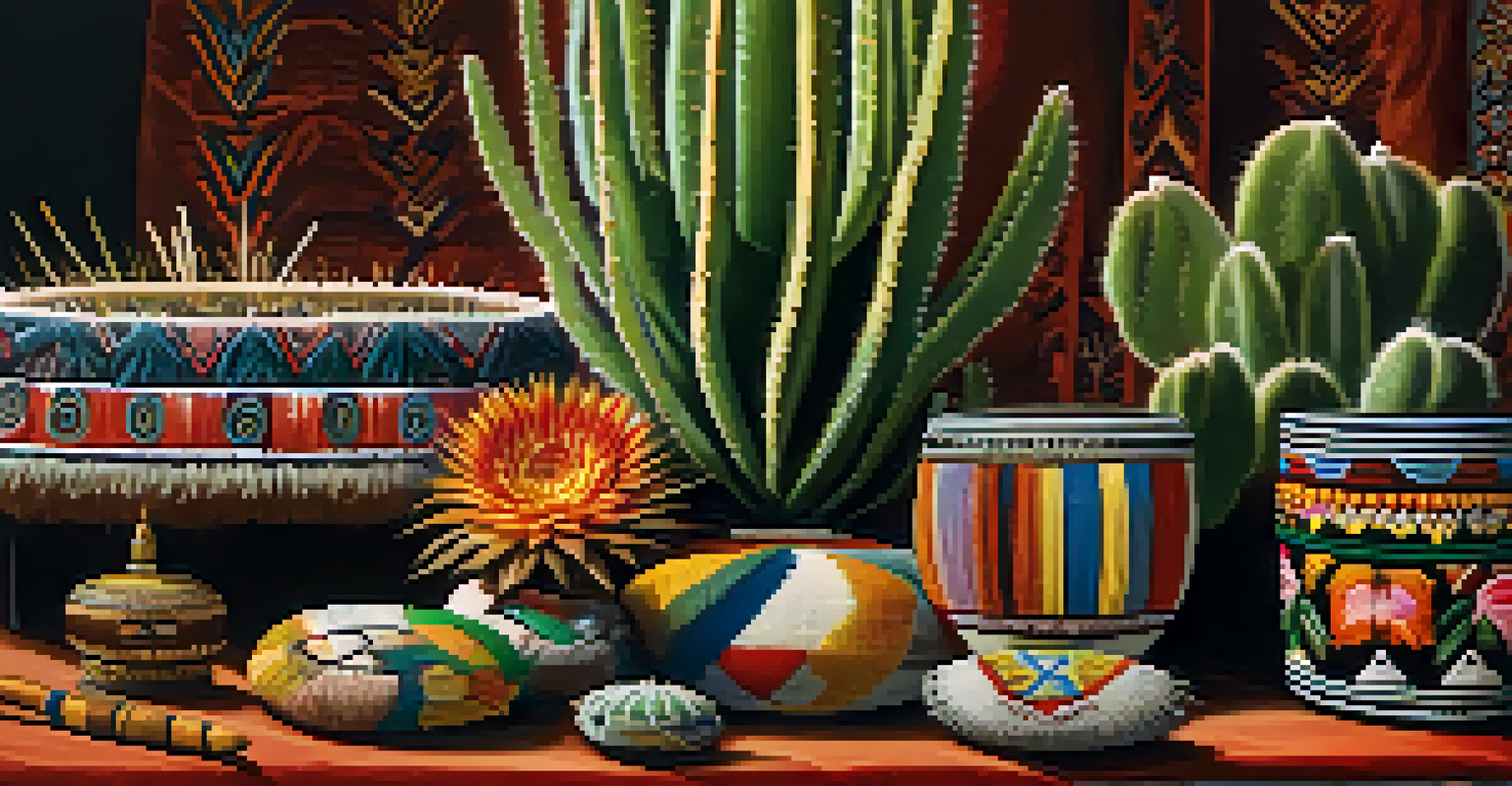Rituals and Peyote: A Deep Dive into Indigenous Healing

Understanding Peyote: A Sacred Cactus
Peyote, a small cactus native to Mexico and the southwestern United States, has been used for thousands of years in Indigenous cultures. Its psychoactive component, mescaline, is known for inducing altered states of consciousness, which many Indigenous peoples view as a pathway to spiritual insight. The cactus is revered not just for its effects, but as a sacred plant integral to cultural identity and community rituals.
The plant is not just a substance; it is a powerful teacher that offers profound insights into the human experience.
In many traditions, peyote is consumed during ceremonies led by a designated healer or shaman. These rituals often emphasize connection to nature, ancestors, and the spirit world. The preparation and consumption of peyote are conducted with great respect, highlighting the importance of intention and the appropriate setting in spiritual practices.
Peyote is not just a recreational substance; for Indigenous peoples, it serves as a bridge between the physical and spiritual realms. This deep reverence for the plant is reflected in the various ceremonies surrounding its use, which often include songs, prayers, and communal sharing, creating a profound sense of belonging and purpose.
The Role of Rituals in Indigenous Healing
Rituals play a crucial role in Indigenous healing practices, serving as a means to restore balance and harmony within individuals and their communities. These rituals often involve the use of natural elements, music, dance, and storytelling, all aimed at promoting spiritual and emotional well-being. They create a safe space for participants to explore their emotions and experiences, fostering healing through connection.

During peyote ceremonies, participants engage in a variety of rituals that may include purification practices, drumming, and chanting. These elements help participants to focus their intentions and create a sacred atmosphere conducive to healing. The communal aspect of these rituals reinforces the idea that healing is a collective journey, not just an individual one.
Peyote's Cultural Significance
Peyote is a sacred plant in Indigenous cultures, symbolizing spirituality and community connection.
By integrating peyote into their healing rituals, Indigenous peoples tap into the plant's perceived spiritual powers. This practice not only aids in personal healing but also strengthens community ties, as participants share their experiences and insights gained during the ceremony. This sense of togetherness is vital for emotional and psychological healing.
Cultural Significance of Peyote in Indigenous Communities
Peyote is deeply woven into the cultural fabric of many Indigenous communities, symbolizing resilience, spirituality, and connection to the land. For many tribes, including the Native American Church, peyote is considered a sacrament, and its use is protected under U.S. law for religious purposes. This cultural significance is vital for preserving Indigenous identities and traditions in a rapidly changing world.
Rituals are the sacred bridges that connect the physical world with the spiritual realm, facilitating healing and community bonding.
The rituals surrounding peyote consumption often reflect the values and beliefs of the community, including respect for nature and the interconnectedness of all living beings. Participating in these rituals reinforces cultural heritage and continuity, providing younger generations with a sense of identity and belonging.
Moreover, the resurgence of interest in peyote rituals among Indigenous youth highlights a broader movement toward reclaiming traditional practices. Engaging with peyote ceremonies allows individuals to not only connect with their ancestry but also to address contemporary issues such as mental health and community disconnection.
Psychoactive Effects of Peyote and Their Healing Properties
The psychoactive effects of peyote, primarily caused by mescaline, can lead to profound psychological experiences. Users often report heightened awareness, visual and auditory hallucinations, and a deep sense of connection to themselves and the universe. These effects can facilitate introspection, allowing individuals to confront personal challenges and traumas in a supportive environment.
Many participants in peyote rituals describe experiencing a sense of clarity and insight that can help them make sense of their lives. This transformative potential is why peyote is seen as a powerful tool for healing, providing access to emotions and thoughts that may be difficult to explore in everyday life. The altered state induced by peyote allows for a unique perspective on personal issues.
Healing Through Rituals
Indigenous healing practices, including peyote ceremonies, emphasize community and the restoration of balance.
However, it's essential to approach peyote with respect and caution. The experience can vary widely among individuals, and it's crucial that ceremonies are conducted by knowledgeable leaders who can guide participants through their journey. This ensures that the healing process is safe and meaningful, honoring both the plant and the participants.
Challenges Facing Peyote and Indigenous Practices
Despite its cultural significance, peyote faces numerous challenges, primarily due to overharvesting and habitat loss. As demand for peyote increases, particularly from non-Indigenous users, the sustainability of this sacred plant is at risk. This not only threatens the plant itself but also the traditional practices of Indigenous communities that rely on it for spiritual and healing purposes.
Additionally, the legal landscape surrounding peyote use can be complicated. While Indigenous peoples have certain protections for its religious use, non-Indigenous users often face legal restrictions. This discrepancy raises ethical questions about cultural appropriation and respect for Indigenous traditions, highlighting the need for greater understanding and advocacy.
These challenges underscore the importance of supporting Indigenous rights and practices. Advocating for the preservation of peyote and its traditional uses can help ensure that future generations have access to their cultural heritage. Educating the public about the significance of peyote and the need for sustainable practices is essential for protecting this sacred plant.
Modern Interpretations of Peyote Use
In recent years, there has been a growing interest in the therapeutic potential of peyote and other psychedelics for mental health treatment. This has led to increased discussions about the appropriate contexts for their use, often sparking debates about cultural appropriation. While some modern practitioners aim to respect Indigenous traditions, others face criticism for commodifying these sacred practices.
As more people explore the healing properties of psychedelics, it’s essential to acknowledge the cultural origins of these practices. Respectful engagement with Indigenous wisdom can provide valuable insights into the responsible use of peyote and other plants. This dialogue can help bridge the gap between traditional practices and modern therapeutic approaches, fostering a greater understanding of holistic healing.
Challenges to Peyote's Future
Overharvesting and legal complexities threaten peyote's sustainability and the cultural practices surrounding it.
However, this modern interest also necessitates careful consideration of ethics and consent. It’s crucial to involve Indigenous voices in conversations about peyote, ensuring that their knowledge and experiences are honored and respected. This collaborative approach can help create a more inclusive framework for understanding the healing potential of peyote.
A Path Forward: Respecting Indigenous Knowledge
To honor the traditions surrounding peyote and Indigenous healing, it's important to foster respectful relationships between Indigenous and non-Indigenous peoples. This involves listening to Indigenous voices, understanding their cultural significance, and supporting their rights to practice their traditions freely. Acknowledging the history of colonization and its impact on these communities is a crucial first step in this process.
Education plays a key role in this journey. By sharing knowledge about the cultural, spiritual, and medicinal aspects of peyote, we can promote awareness and appreciation for Indigenous practices. This understanding can help dismantle stereotypes and misconceptions surrounding Indigenous cultures, fostering a more respectful dialogue.

Ultimately, the future of peyote and Indigenous healing practices lies in collaboration and mutual respect. By supporting Indigenous communities in their efforts to protect their traditions, we can help ensure that these sacred practices continue to thrive for generations to come, enriching not only their communities but also the broader understanding of healing.